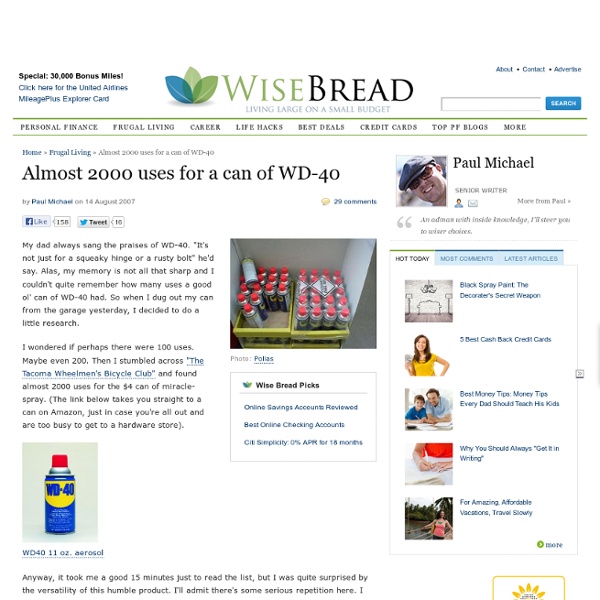Almost 2000 Uses For WD 40
I've been enjoying browsing this site today. Thanks for so much great info. I just wanted to add my $0.02 (as a former mechanic) on WD40 that fellow frugalists might appreciate: As another poster mentioned, WD40 is a penetrating oil, not explicitly a lubricant. It works great on a lot of things, but it has some problems--foremost is that because it is a consumer-oriented product it doesn't have very strong solvents (key to the "penetrating" part) and tends to get sticky and attract dirt and other crud which can make whatever you were trying to clean or lubricate worse in the long run. Second, it's an aerosol, which means that whenever you use it, even if you use the little straw, you are going to be wasting a lot of product (and making a mess). I suggest you using a trade-oriented liquid penetrating oil for all of the 200 uses above. Finally, two more uses for penetrating oil... 1) it's a great de-fogger.
How To Clean Copper ... Naturally
Copper is found in many fine household items, such as jewelry and pots. Over time, though, the surrounding air causes the metal to tarnish, and who wants to display tarnished copper? Tarnishing is a natural process, so it makes sense to use natural items to eliminate the dark, grimy appearance. Commercial copper cleaners often contain harsh chemicals, but you can naturally clean copper with materials usually already found in your home. Vinegar and salt: Rub a mixture of 1 tablespoon of table salt and 1 cup of white vinegar onto the copper with a soft cloth and rinse. To keep your copper shiny longer, you can spray or polish a lacquer. Science experiment When thinking of copper, people often think of pennies. Once the silver is shiny again, how do you keep is so? Know more about how to clean copper?
How To Clean Brass Naturally
Made from a combination of zinc and copper, brass is a popular metal found in cookware, jewelry, musical instruments (brass band, anyone?) and home decorative objects. If your house is of a certain age, many of your doorknobs may be brass. Like the metals from which it is made, brass also tarnishes easily. If you have a tarnished or dirty brass piece that needs cleaning, how you do so depends on whether it is lacquered – i.e. coated with a protective glossy finish – or non-lacquered brass. Cleaning non-lacquered brass requires more elbow grease. Ketchup: The housekeeping guru who has been writing the syndicated “Hints from Heloise” column for more than 30 years recommends this kitchen staple. When might you want to leave your brass piece tarnished? And if you are disappointed to discover that what you thought was brass is simply brass-plated? Have other ideas for how to clean brass? More how to articles on MNN:
Restoring & Seasoning Rusty Cast Iron
There are a few tools that every cook should have in their kitchen - a great seat of knives, a heavy-duty stand mixer, a food processor, stainless steel nesting mixing bowls, a Dutch oven, and a cast iron skillet. Cast iron is one of those things that people either LOVE, or it scares the beejesus out of them because they don't understand it. The reasons against cast iron are that: 1. 2. 3. Once you cook with a well-seasoned cast iron skillet, all of the above reasons just fall away. 1. 2. 3. 4. 5. 6. 7. 8. You can keep adding oil and baking as many times as you want. A quick and final note on cast iron. May your thrift store adventures bring you a cast iron gem of your own. Sarah C writes about doing more with less, gardening, wholesome from-scratch food, and DIY, with silliness and snark at beingfrugalbychoice.blogspot.com.
Related:
Related:



